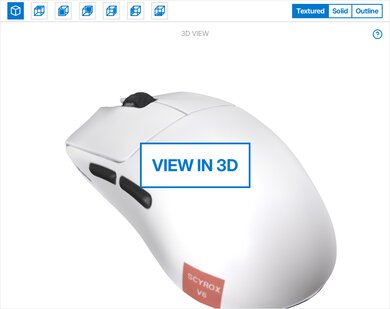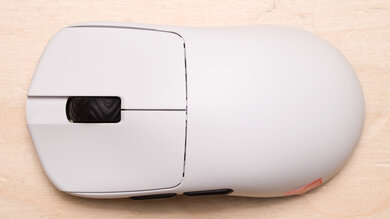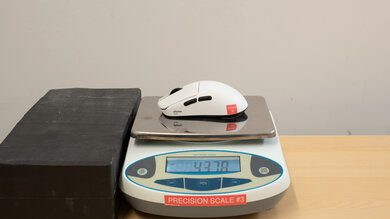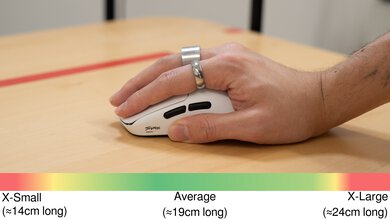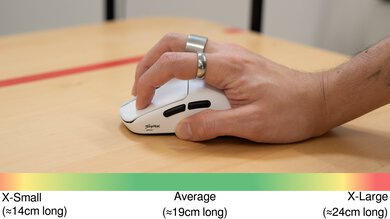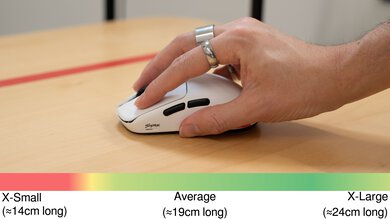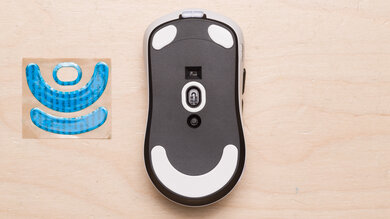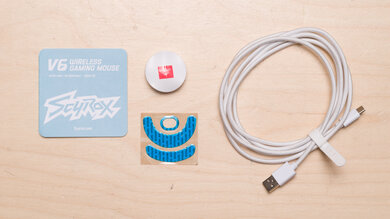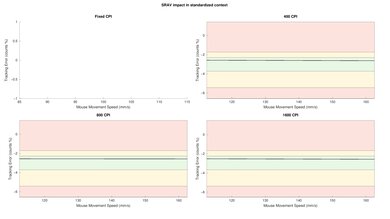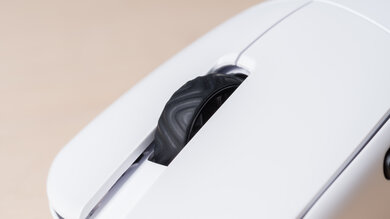The Scyrox V6 is a lightweight wireless gaming mouse with a symmetrical shape and a subdued design. It's a medium-sized mouse that's on the smaller side and has a fairly high profile hump in the center. It uses PixArt's flagship PAW3950 sensor and supports a maximum wireless polling rate of 8000Hz. It uses Omron Optical switches and has a web-based configuration software.
Our Verdict
The Scyrox V6 is a decent mouse for work, despite not being explicitly designed for it. It has excellent build quality and a fairly accommodating symmetrical shape. You can easily remap its buttons to your liking using its web-based companion software. While you can connect to it wirelessly using a USB receiver, it doesn't support Bluetooth or multi-device pairing.
Excellent build quality.
No Bluetooth connectivity or multi-device pairing.
Scroll wheel lacks free scrolling and L/R tilt inputs.
The Scyrox V6 is a fantastic FPS gaming mouse. Its remarkably lightweight makes it easy to move, flick, and aim accurately and quickly. It also has excellent build quality and a symmetrical shape that's well-suited for palm and claw grippers of most hand sizes. It also delivers outstanding raw performance, making it suitable for gaming at any competitive level.
Excellent build quality.
Incredible raw performance.
Exceptionally lightweight.
Despite not being designed for it, the Scyrox V6 is good for MMO and MOBA gaming. It has excellent build quality, a comfortable and lightweight symmetrical shape, easily programmable buttons, and fantastic raw performance. That said, it doesn't have nearly as many additional buttons as dedicated MMO mice.
Excellent build quality.
Incredible raw performance.
Fewer additional buttons than dedicated MMO mice.
The Scyrox V6 has exceptional raw performance. It delivers incredibly low and consistent click latency and has outstanding overall sensor performance. It also supports a maximum polling rate of 8000Hz
8000Hz maximum polling rate.
Exceptional click latency.
Superb sensor latency and accuracy.
Changelog
-
Updated Nov 27, 2025:
We've added a link to the Logitech G PRO X SUPERLIGHT 2c in the Hand Size Recommendation section.
- Updated Aug 28, 2025: We've converted this review to Test Bench 1.5.1. This update removes less relevant or redundant elements, including several videos. We've also adjusted our Sensor Latency testing, resulting in minor score changes. See our full 1.5.1 changelog for details.
- Updated Apr 30, 2025: Review published.
- Updated Apr 11, 2025: Early access published.
Check Price
Differences Between Sizes And Variants
The Scyrox V6 is available in Black, White, and Blue color variants. We bought and tested the White colorway. It doesn't have a visible label.
Popular Mouse Comparisons
The Scyrox V6 is a lightweight wireless gaming mouse with a solid plastic shell and a medium-smallish symmetrical shape. It has a fairly high, centered middle hump and closely resembles the G-Wolves HTS+ and the LAMZU MAYA X. It's a fairly versatile shape that can acommodate a range of hand sizes and grip types, but it's ideal for palm or claw grippers with medium-sized hands. As for performance, it's among the best and compares well to the Razer Viper V3 Pro and the Logitech G PRO X SUPERLIGHT 2. The Scyrox enters a quickly crowding space of lower-mid range to upper mid-range, incredibly lightweight gaming mice like the Scyrox V8, the Ninjutso Sora V2, and the Hitscan Hyperlight. These are all great alternatives to the more expensive flagship offerings from Razer and Logitech if you'd like to save some money and don't mind buying products from lesser-known brands.
For more recommendations, see our picks for the best FPS mouse, the best claw grip mouse, and the best lightweight mouse.
The Scyrox V6 and the Scyrox V8 are both lightweight, wireless gaming mice from the same company. They share the same internals and deliver nearly identical raw performance, but they have different shapes. The V8 has an aggressive rear hump that makes it ideal for claw grippers, whereas the V6 has a centered hump that's well-suited for both claw and palm grips.
The Hitscan Hyperlight and the Scyrox V6 are lightweight wireless gaming mice with symmetrical shapes. They're fairly similar design-wise, but the Hitscan is smaller overall and has a lower profile. They're both well-suited for most grip types, but the Scyrox is more accommodating for larger hands. Also, the Hitscan has an open bottom plate to achieve its lightness, whereas the Scyrox has a completely solid shell. Under the hood, the Hitscan has a PixArt 3395 sensor, while the Scyrox uses the newer 3950. They perform remarkably similarly, but the Scyrox supports an 8000Hz polling rate out of the box, whereas the Hitscan requires you to purchase an additional 8000Hz reciever.
The LAMZU MAYA X and the Scyrox V6 are lightweight wireless gaming mice with symmetrical shapes. The LAMZU is slightly bigger with a somewhat flatter profile, while the Scyrox has a more aggressive middle hump. They both sport a flagship PixArt 3950 sensor and deliver outstanding performance. That said, the LAMZU has an open bottom plate, which leaves the interior open to dust and debris.
The Scyrox V6 and the MCHOSE L7 Pro are lightweight wireless gaming mice. The Scyrox has a higher profile shape with a centered middle hump, while the MCHOSE has a lower profile hump placed closer to the rear. This makes it better suited for a slightly more aggressive claw grip, or even fingertip, but the Scyrox has a more versatile shape overall. Beyond shape differences, the Scyrox has a slightly more solid-feeling build and better mouse feet, but both mice have similar fantastic raw performance. Additionally, the MCHOSE supports Bluetooth.
Test Results

The Scyrox V6 has a fairly conventional design without many frills or extravagant details. It doesn't have any RGB lighting, but there's a status LED below the Scyrox logo on the front left side of the mouse. The baseplate, side buttons, and scroll wheel are black, regardless of whether you get the White, Blue, or Black color option.
This mouse has excellent build quality. It's made of solid plastic that has a soft-touch, matte finish that's comfortable in hand. It doesn't have any significant flex or rattling that's noticeable during normal use, but the bottom plate has some flex, and you can actuate the middle click button if you push hard enough.
The Scyrox V6 has a symmetrical shape with a well-rounded, somewhat high-profile centered hump that provides good palm support for claw and palm grips for most hand sizes. That said, its taller hump isn't ideal for fingertip grip as it can get in the way. Its shape closely resembles that of the G-Wolves HTS+ and the LAMZU MAYA X.
If you're interested in a mouse with a very similar shape overall that's a bit shorter in length and has a more rounded, less locked-in back end, check out the Logitech G PRO X SUPERLIGHT 2c.
This mouse has a 250 mAh battery. Scyrox doesn't advertise a battery life estimate, but we've been seeing reports of users getting 1–2 days of battery life with heavy use at higher polling rates and up to a week with lower polling rates and lighter use. If you have this mouse and want to share your experience with battery life, let us know in the comments.
This mouse comes with a paracord-like cable that's quite thick and heavy. Despite its weight, it's still quite flexible but adds some friction when gliding across mouse pads.
You can reprogram the left and right click buttons, the scroll click, both side buttons, and the CPI button on the underside of the mouse. The left click must always be bound to a button.
This mouse has remarkable click latency and is suitable for the highest caliber of competitive gaming.
We tested it at its maximum wireless polling rate of 8000Hz and maximum wired polling rate of 1000Hz with motion sync turned off and competitive mode enabled.
This mouse's sensor exhibits no problematic variation or tracking accuracy issues.
This mouse has fantastic sensor latency performance suitable for gaming at any competitive level.
The above results are using a wireless polling rate of 8000Hz with motion sync turned off and competitive mode turned on.
The table below shows the results of supplementary testing we conducted at different polling rates.
| Connection Type | Polling Rate | Delay to Start of Movement | Delay at Half Movement | Delay to End of Movement |
|---|---|---|---|---|
| Wireless | 1000Hz + Motion Sync | 12.8 ms | 3.9 ms | 5.7 ms |
| 4000Hz | 13.0 ms | 2.1 ms | 4.1 ms |
The available polling rate options are 125Hz, 250Hz, 500Hz, 1000Hz, 2000Hz, 4000Hz, and 8000Hz.
This mouse features motion-sync, 'Competitive,' and 'Long Distance' modes. We conducted all of our testing with motion-sync and 'Long Distance' modes turned off and 'Competitive Mode' turned on.
The main click buttons, side buttons, and scroll wheel are all quiet and aren't likely to bother anyone around you.
Scyrox S-center is a web-based software that allows you to configure CPI and polling rates, set profiles, reprogram buttons, and more. It's well laid out and easy to use. Still, some of the tooltips don't offer particularly insightful explanations for what some settings, like the 'Competitive' and 'Long Distance' modes, do. Scyrox also offers a downloadable version of the S-Center software.


